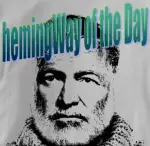 A randomly selected audio treat recently returned me to the world of Ernest Hemingway, whom I have not read for years now, but who I feel as strongly about as ever.
A randomly selected audio treat recently returned me to the world of Ernest Hemingway, whom I have not read for years now, but who I feel as strongly about as ever.
This is a novel about the Missuses Hemingway: Hadley, Pauline, Martha, and Mary. Therefore it begins in Antibes, France (with flashbacks to Paris and Chicago, where Hadley and Hemingway met), and follows the strangely morphing family to Key West, Cuba, Spain, London, and Idaho. Chapters are told from the point of view of each Mrs. Hemingway in turn. These are third-person perspectives, but very close.
How to sum up this story I feel I know so well? Hadley Richardson is the first wife. Older than Hemingway, she had resigned herself to spinsterhood and is called ‘homely.’ Their marriage was most innocent, since another hadn’t ended to allow for it. They had a baby, Bumby; they lived together in Paris, dirt poor and very happy – these years are later mythologized by Hemingway in such terms. Next comes Pauline Pfeiffer, or Fife, a wealthy socialite who inserted herself into the Hemingway marriage, as a close friend to Hadley as well as to Hem; she made a concerted effort to win him, which she did. This breaking point opens the novel: Hadley gives Hem a tearful ultimatum, and then issues her conditions for divorce. She wants him and Fife to spend 100 days apart to decide if they’re really serious. Then she lifts the requirement, out of sympathy for the lovers’ plight.
Fife was Hem’s longest-lasting wife. They had two sons, Patrick and Gregory, and settled in Key West. Fife’s section also opens near its end: Hemingway returns from Spain, where he’s been covering the Spanish Civil War, and alternates between treating Fife better than ever, and sort of teasing her with his new mistress, Marty. Fife is the only one of his divorces to really fight to keep him, beg him to stay. She loses, and the two are never on excellent terms again. Cue Marty, or Martha Gellhorn, herself an accomplished war correspondent: Hemingway’s problem with her is her independence, her own writerly accomplishments, her refusal to wait at home for him. They have been apart for some time when she shows up in Madrid to find him and break it off, only to learn he’s taken a lover, Mary. This upsets Marty briefly, but then the two women meet and team up in taking care of him. His drinking and self-sabotage are worsening, and Marty is relieved to pass him on to the next wife.
Mary Welsh was there at the end, when he shot himself with both barrels of a shotgun in their home in Ketchum, Idaho, and much of her section of the book takes place after his death, as she tries to sort through papers and her own grief. Here Mary receives a final visit from a most interesting secondary character, one whom Naomi Wood invented: Harry Cuzzemano, a collector/dealer of books and literary ephemera, who has harassed all four wives for papers and especially, the famous briefcase Hadley lost at the Gare de Lyon. (If you don’t know, go look up this most fascinating mystery in the Hemingway legend.) The final meeting with Harry is part of the final wrapping-up, which is a little odd (he has been peripheral throughout) and a little appropriate (he has been a through-line, and in making his own final peace, he helps Mary find hers). The last moments involve Mary’s coming to terms with the fact that Hemingway was not the fatal victim of a gun accident, as she’s been claiming. I can only imagine how difficult this must be. There was plenty of evidence in support of a suicide – his mental health in the last years of his life, several suicide attempts, forensic evidence – but how hard it still must be.
Mrs. Hemingway was an enjoyable read (listen) for me. Each of these four women is evoked in her own fashion. I loved feeling steeped in Hemingway again, after too long. These stories were familiar, although the particulars were often new. Kate Reading (great name), who narrates the audiobook, did a good job: I did not think of her a bit, which is the ideal, meaning that her role as reader kind of disappeared for me and I felt I was receiving the book unadulterated. I see that Naomi Wood spent time with letters and papers written by each of these women, and I feel good about her fictionalized but faithful representations.
As a gentle criticism, I guess I would say that this still felt like a book about the man, more than about the women. Maybe that’s the only way to go, with such a massively larger-than-life male lead; at least three of the wives were most famous for being just that, and it seems Hemingway had this effect on women (and men, too), that everything becomes about him. They all four loved him in their own ways. They all kept in touch in their own ways, or didn’t: Hadley and Hem remained chums; Pauline was an antagonist, but a co-parent, so some contact was necessary; Marty and he never spoke after their divorce. I appreciated how they kept in touch with each other, too (or didn’t), including the friendship between Mary and Hadley, the first and last wives, whose relationship was largely a collaboration on how to best care for the man they’d all shared. There’s something deeply creepy about this polygamous-feeling string of women. But it’s true to life, as far as I can tell. (As an aside, I’ve always wondered what my relationship with Hem would have been, if we’d been alive at the same time. Would I have been able to resist his prodigious charms, and see what a cad he was?)
This is a book of high emotions, love and devotion and anger and betrayal and rejection. Looking over that last paragraph, I don’t think I mean to criticize, after all. I think the Hemingway focus is accurate. He’s what these women have in common. If it’s a little less than feminist and empowering to be so mad for this flawed man, so be it: it’s what happened. I am glad that Wood gave each woman her own time and her own personality. I’m glad to be with the flawed man again, myself. I’m very glad I read this book. It was sweet and harrowing, and engulfing. Recommended.
Rating: 7 shallow white bowls.
Filed under: book reviews | Tagged: audio, Hemingway, historical fiction | 5 Comments »
Paul Hendrickson, NBCC award-winning nonfiction author for Sons of Mississippi, pulls off the remarkable feat of finding a fresh, new angle from which to approach Ernest Hemingway: his boat Pilar. Purchased in 1934 with an advance from his longtime publisher Scribner, she saw him through three wives, great achievements and critical failures in his writing career, big fish and little ones, and the beginnings and the endings of many relationships. Hendrickson suggests that Pilar may have been the love of Hemingway’s life.













 This movie is about Perkins’s relationship with Thomas Wolfe (although Fitzgerald and Hemingway make brief appearances). I knew almost nothing about Wolfe when I came to the film, and my impressions of Perkins were hazy, based on what I know of Fitzgerald and Hemingway: I understood him to be a decent, humble, kind man, well-suited to handle such stormy personalities and expert at doing so. He is known to be both a very fine editor and a very fine guardian and guide to the difficult men who were his three most famous writers.
This movie is about Perkins’s relationship with Thomas Wolfe (although Fitzgerald and Hemingway make brief appearances). I knew almost nothing about Wolfe when I came to the film, and my impressions of Perkins were hazy, based on what I know of Fitzgerald and Hemingway: I understood him to be a decent, humble, kind man, well-suited to handle such stormy personalities and expert at doing so. He is known to be both a very fine editor and a very fine guardian and guide to the difficult men who were his three most famous writers.  I’m afraid I’m quite late in writing this review: it has been at least a month since I saw this movie at a local theatre. I was really hoping for a reprise so I could take Husband to see it, and see it a second time for myself, but no luck. I recall my impressions, though, and will share them here.
I’m afraid I’m quite late in writing this review: it has been at least a month since I saw this movie at a local theatre. I was really hoping for a reprise so I could take Husband to see it, and see it a second time for myself, but no luck. I recall my impressions, though, and will share them here.